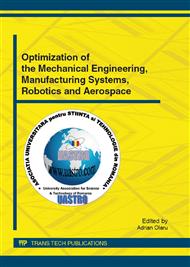p.169
p.176
p.182
p.188
p.194
p.200
p.208
p.214
p.221
Torsor Evaluation of the Tooth during the Milling Process
Abstract:
Analysis of the torsor evolution in milling process is very important for optimization of the cutting process to achieve high quality of manufacturing, productivity and cost. Our study is based on the analysis of the Mx, My and Mz moments‘ evolution at the tooth tip of the tool during the milling process. A complex experiemntal setup is designed and realized to obtain a three-dimensional response of the mechanical actions. During the tests, the complete torsor of mechanical actions generated by the cutting process were measured by six components dynamometer (forces and moments according to each direction). In this paper a method for tool position determination in milling process is presented, with purpose to transport and evaluate the moments to the tooth tip of the milling cutter.
Info:
Periodical:
Pages:
194-199
Citation:
Online since:
June 2012
Keywords:
Price:
Сopyright:
© 2012 Trans Tech Publications Ltd. All Rights Reserved
Share:
Citation:


